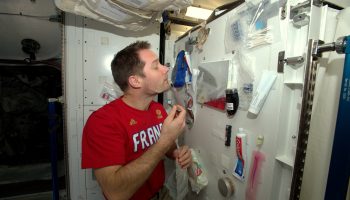Thomas Pesquet is on the International Space Station for six months for his Proxima mission. His programme is foremost science-based. But how does he spend his days? What follows is an overview of an astronaut’s typical day.
There is indeed a “typical day” for an astronaut on the International Space Station! Far from spending all his time observing the magnificent spectacle that is Earth seen from the Cupola, Thomas Pesquet follows a well-defined schedule every day.
MORNING
6H/6H30: The alarm clock rings for Thomas Pesquet. He then has about an hour to extract himself from his sleeping bag that is attached to a wall or the ceiling of his cabin, to wash himself using special wipes, to have breakfast and to have a look at his schedule for the day, which was sent to him by the control centre overnight.
7H/7H30: The serious things begin, starting with a first audio conference with the control centers on Earth (Columbus Control Centre near Munich, Germany for Europe). This is the time for the astronauts and ground crews to discuss the schedule of the day and cover questions.
Then everybody on the Station goes off to run their programme.
Thomas Pesquet devotes 50% of his time to scientific research, meaning he will for example spend his morning in the Columbus laboratory performing experiments.
NOON
12H/12H30:
In general, each astronaut eats lunch by themselves. Thomas Pesquet testifies: “Everybody grabs the space equivalent of a sandwich, then goes right back to their activities.”
AFTERNOON
13H/13H30: If the astronaut devoted his morning to science, he spends the afternoon performing maintenance or logistics tasks, and vice versa. As the International Space Station is the astronauts’ home during their mission, it requires everyday maintenance work just as any house on Earth!
17H/19H: Similar to people on Earth who spend their evenings at the gym, sport is part of the routine of the astronauts 400 km above our heads. Staying in good physical condition is essential when moving in weightlessness. For this purpose, treadmills, an indoor (or more appropriately in-Station) bike and a work-out machine are available to astronauts for their daily – and compulsory – training!
EVENING & WEEKENDS
19H: There is a closing conference with the control centres – a last contact with the ground teams to end the week – to ensure that everything is in order and that everyone’s programme has been completed.
To end the day, the crew have some free time. They usually take advantage of this by dedicating themselves to individual activities (writing their logbook, relaxing with music, calling or corresponding with their loved ones) or collective activities (joint dinner, watching movies together…).
The famous cupola of the International Space Station is also a much appreciated place for the fantastic view it offers of Earth. Of course the astronauts also dabble in the art of the selfie!
BONUS
This daily routine – also referred as the “space routine” by Thomas – is sometimes disrupted by rare events such as spacewalks. Spacewalks are usually organised for assembly, maintenance and repairs of the International Space Station. Thoroughly prepared and programmed well ahead of time due to the risk they represent, nothing is left to chance.
The Proxima mission includes four programmed extravehicular activities.
DAY/NIGHT
There are 16 sunsets and sunrises on the ISS every 24 hours, so it is not easy to know when it’s time to go to sleep. The astronauts work and sleep according to a daily schedule on GMT time. They usually have eight hours of sleep at the end of each day. They can wear a blindfold on their eyes or close the shutter of their window to not be bothered by the sunlight during their sleep.
Source: https://proxima.cnes.fr/fr/impesanteur-boulot-dodo-la-routine-de-lastronaute








Discussion: 5 comments
Très intéressant.
😉
Merci pour toutes ces informations très intéressantes
Beautiful post. Thanks for sharing, dear Thomas. Have a fantastic weekend on board the ISS.
Good text.. Just one precision… “Quartier libre” (Free time) in French from the original blog entry is not translated by “Quarter of an hour” in English. False friend ! 🙂
On the ISS , it seems that the “Pre-Sleep” activity is about 2 hours from 19:30 to 21:30 . Including dinner.
Source : OSTPV software screenshot here : https://i.stack.imgur.com/tv2p2.jpg
Merci beaucoup pour toutes ces précieuses informations sur la réalité du métier d’astronaute. Cela permet de montrer la réalité d’un métier qui est souvent fantasmé.Savez-vous où il serait possible d’otbenir encore plus de renseignement, plus de détail sur l’entraînement des astronautes ? Y-t-il un journal de bord ? un document de formation détaillé ?
Merci d’avance.